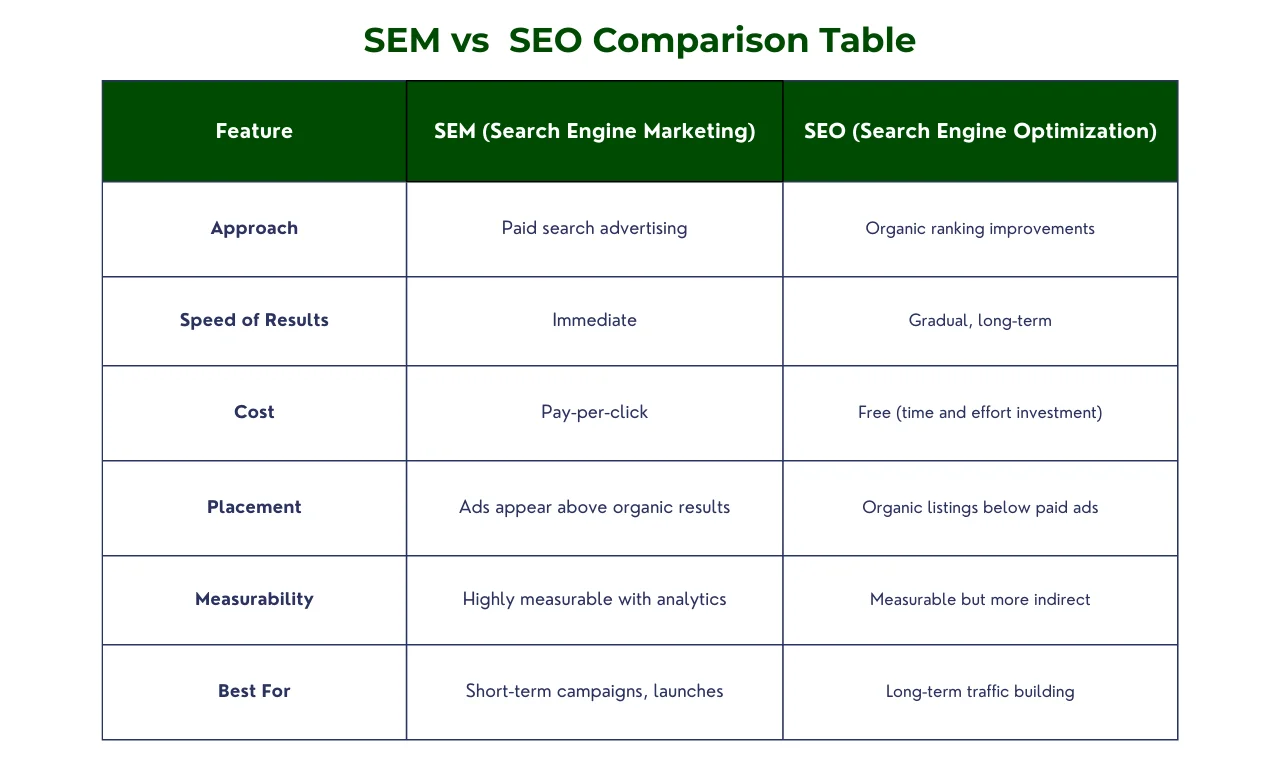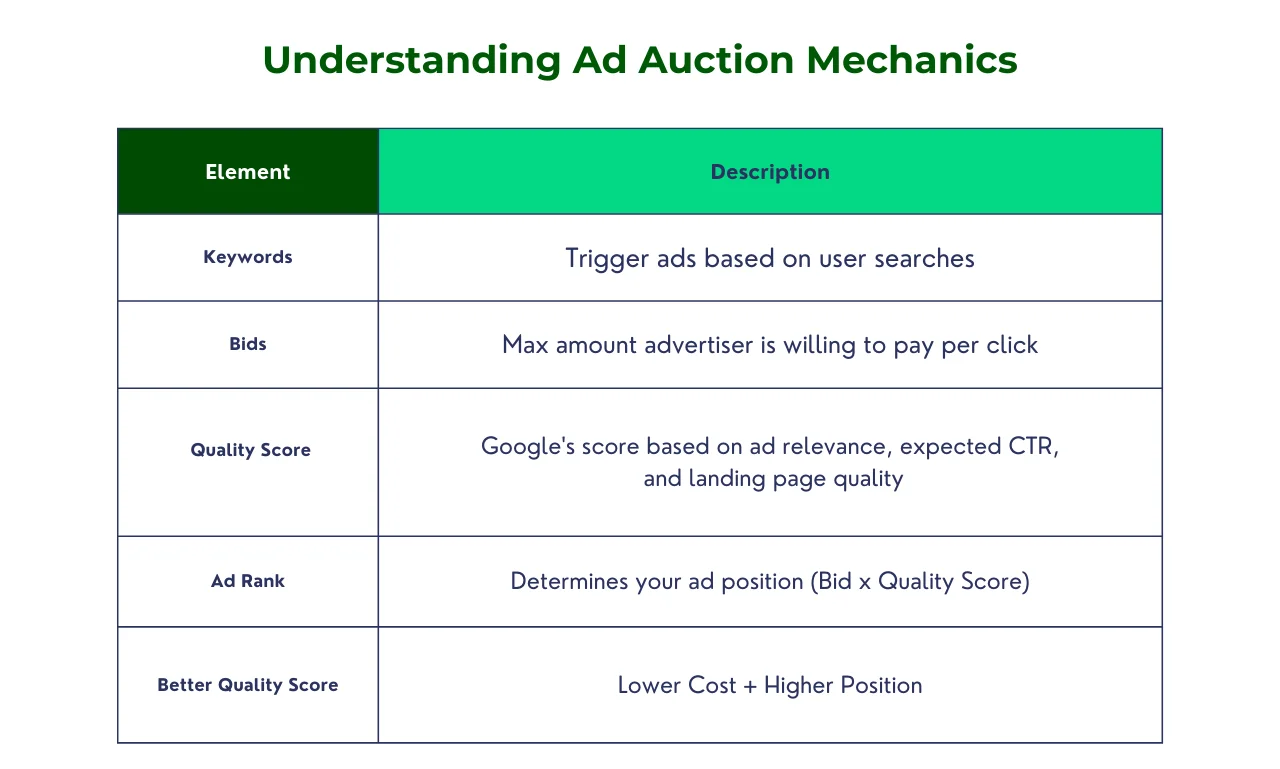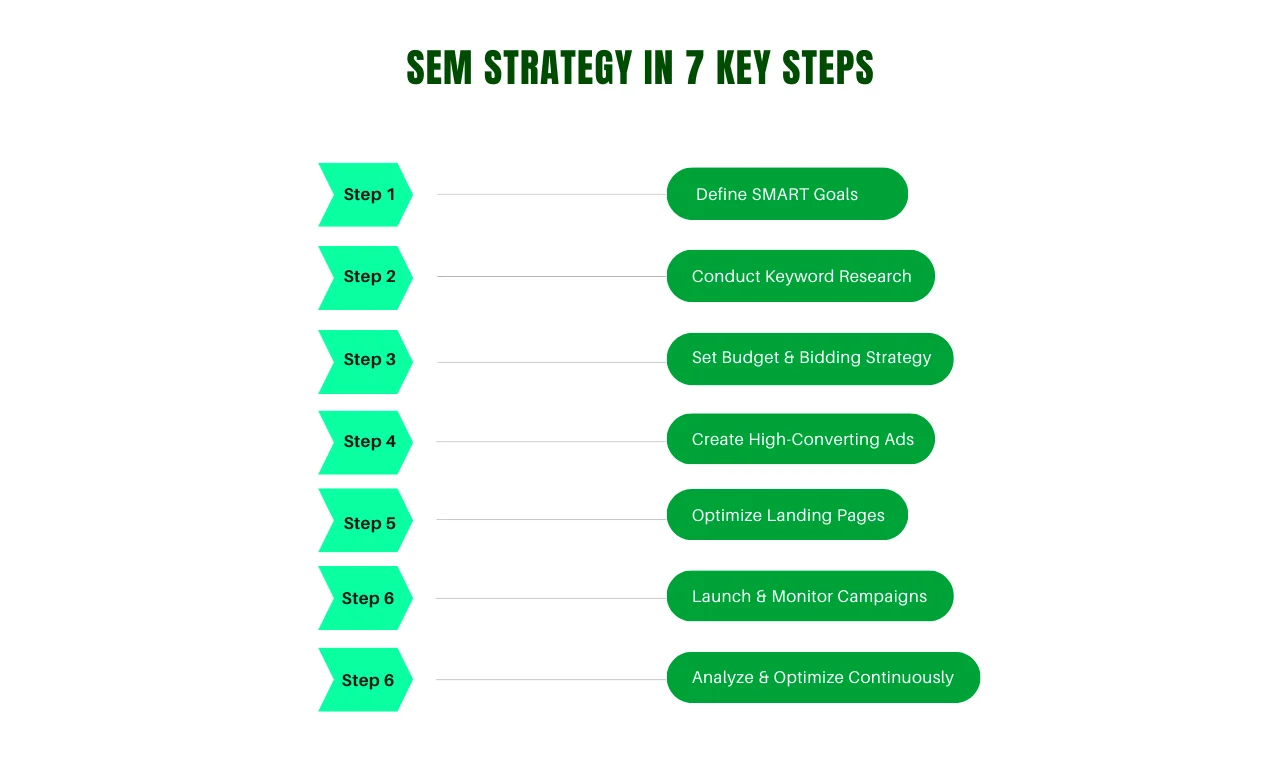Digital marketing has become a popular tool that helps businesses to get in touch with their target audience. Among all the digital marketing tools, Search Engine Marketing is the most reliable tool.
SEM is an effective support tool for a digital marketing plan because it helps to improve the business’s visibility on the internet, attract visitors to websites, and create leads. In this post, we will define what SEM is and how it works, as well as the types of SEM techniques that are available.
1. What Is Search Engine Marketing (SEM)?
SEM is the process by which websites can use different marketing techniques to position higher on the SERPs with the use of paid advertisements. SEM is a marketing strategy that incorporates techniques such as Paid Search or pay-per-click (PPC) advertising, display advertising, and so on. It is different from Search Engine Optimization (SEO) which deals with improving the website, not by paid methods, but by bettering the quality and ranking on the search engines.
Why SEM Matters?
SEM is important for any business that wants to enhance its online visibility. As people perform hundreds of millions of searches daily on different search engines, SEM places your company straight on the customer path. Through SEM, you can boost circulation and achieve many objectives of your website due to its high return on investment (ROI). SEM could be very beneficial for any company from small businesses to a large-scale firm.
SEM vs. SEO:
SEO, on the other hand, focuses on improving a site’s ranking within search engines through the proper use of keywords, good-quality content, and backlinks. On the other hand, SEM focuses on paid advertising methods to attain immediate results. Even though both are very important for a digital marketing campaign, SEM is more suitable for time-sensitive marketing techniques. Check below the table to understand this comparison in more detail.
Key Benefits of SEM:
Here are some key benefits of SEM that will help your business in diverse ways:
- Instant Result: Compared to ‘Search Engine Optimization’ which takes time to have a ranking on search engines, SEM offers this immediate exposure on search engine’s result pages.
- Audience Niche Penetration: Through SEM, clients can select audience niche, geographical location, and even time for the airing of the advertisements.
- Measurable ROI: SEM also makes it possible for businesses to monitor and evaluate the performance of their ads within a short period, unlike other forms of marketing.
2. How Does Search Engine Marketing Work?
SEMs basic working process which helps you understand how it operates is as follows:
Search Engine Algorithms and Ad Auctions:
One of the primary components of SEM entails search engine algorithms as well as ad auctions. Auctioning occurs when a user types a specific query. Then the search engine indicates which ad will be suitable for the SERP. Sellers place bids depending on their interests and advertising tools select advertisements according to their price bid and Quality value, which considers the relevance of advertisements and Web sites.
Keywords, Bids, and Quality Score:
- Keywords: Keywords are the terms or phrases that the users type to search in a particular search engine that form the basis of any SEM campaign. Keywords are also very important when it comes to targeting the appropriate clients who are interested in your website products & services.
- Bids: Advertisers also define the maximum price per click (max. bid) they are ready to allow for their ads. However, the bid amount plays a crucial role in determining the position of the ads amongst the conditions of the auction.
- Quality Score: It determines whether or not an advert is directly related to the user’s search query and the quality of the landing page associated with it. Better ad positions and lower costs are the bonuses that can be gotten from a higher Quality Score.
Ad Appearance on SERPs:
These may be displayed either above or anywhere near the organic search results on the SERP. Ad position depends on bids as well as Quality Score, which expects advertisers to bid a certain sum of money to be placed on top of the list. Relevance of ads as well as properly chosen landing pages actually contribute towards getting a higher Quality Score and a better position of ads.
Importance of Landing Pages and Ad Relevance:
Landing pages and other closely related concepts are rather important to SEM. They are the pages that the user visits after they click on an advertisement concerning the product or service. If the landing page is optimized and is designed according to the ad content that it can take, then conversion rates can be better and the experience for the user too.
Relevance is the assurance that the ad displays the appropriate message that has a close relationship with the search term or phrase and the purpose of the individuals using the search engine, which in return leads to a higher Quality Score.
3. Types of Search Engine Marketing
A. Pay-Per-Click (PPC) Advertising
PPC is among the most used and powerful strategies in SEM marketing. In this method of Internet advertising, the advertiser is charged a certain amount for every click-through made on an advertisement.
Google Ads and Microsoft Advertising are some of the most common available PPC platforms.
PPC’s advantage lies in the fact that it drives traffic and sales immediately from the moment the campaign is launched, so this tool is quite suitable for those companies that expect to get a considerable amount of results during a short period.
B. Display Advertising
Google’s display advertising includes the use of banners and other images on various websites in a network that covers virtually all the web. It is useful to increase the brand recognition of the company and target relevant audiences at the same time. Also, retargeting is an effective approach important for display advertising because it helps businesses communicate with visitors who have already shown interest in a particular internet site.
C. Shopping Ads (Google Shopping & Amazon Ads)
Shopping ads also show the list of products in the search results so that potential clients can see the picture of the product, the price, and other details. Enhancing product feeds is essential to increase the visibility and ranking of the shopping ads. This type of SEM is particularly helpful for e-commerce stores that want to increase sales of their products.
D. Video Ads (YouTube & In-Stream Ads)
Video ads use a format of videos to capture the viewers’’ attention and create awareness of brands. YouTube is an example of in-stream advertisements that can be placed before the video starts, during the video, and after the video ends. It should also be noted that the use of videos produces interesting thought processes and help create better storytelling through the use of the ad format.
E. Local Search Ads (Google Local Services Ads)
Local campaigns are even more effective because local ads target customers in particular regions which makes them suitable for businesses with operational bias in particular areas. They are available for local businesses in search and on Google Maps to help the clients attract local visitors.
F. Remarketing & Retargeting Ads
The two strategies of remarketing and retargeting are used to target users who may have visited given websites but were not convinced to make a purchase. The businesses should make sure to display ads to the users displayed in the above lists so that there will be higher click-through rates and return on investments.
4. How to Create an SEM Strategy in 7 Steps?
SEM is an important part of any company’s online marketing strategy, and building a strong one can definitely increase your site’s traffic. SEM is the process of using paid means in ranking your business, so when users type in your products’ keywords, the business comes to the top of the search page. Let’s discuss seven steps that are very useful to create a good SEM plan. Let’s dive in!
Step 1: Define Your Goals
Before going deeper into what constitutes SEM, goals and objectives have to be set in writing and realistically attainable. These goals are ideal for guiding the whole strategy and defining when the undertaking is successfully completed.
First, decide the goals of SEM that you want to be able to achieve in your campaigns. Do you want to enhance your brand visibility, attract more visitors to your site, make people fill out a form or make a purchase?
Your goals must be SMART is an acronym that stands for Specific, Measurable, Attainable, Relevant, and Time-bound. For example, a SMART goal would be to obtain 20% more visits to the website in the next three months.
Step 2: Conduct Keyword Research
SEM starts with keyword research that is, identifying the most suitable keywords to use in the ranking process. When choosing the keywords, you need to assure yourself that your business is getting in touch with the right people.
Tools like the Google Keyword Planner, SEMrush, Ahrefs, and others, are very handy for this purpose. These tools enable you to find out keywords as well as determine search volumes and extend of competition.
Long-tail vs. Short-tail Keywords:
Short-tail Keywords are general and have a word length of up to two words (for instance, shoes). While most of them attract a large number of searches, they also attract a lot of competitors.
The Long-tail keywords consists of long strings with a minimum of three words, for example, ‘women’s running shoes size 8’. They get fewer searches but are more likely to make conversions because they are less popular and contended.
This means you should concentrate on both the two in order to achieve higher visibility of the site as well as increase its conversion rate. The longer keyword phrases are very suitable in cases where you are dealing with specialty products or services.
Step 3: Set a Budget & Bidding Strategy
It would be appropriate to suggest that setting the budget and bidding strategy is crucial in reaching the proper demographic while still managing to avoid wasting money. It all begins with finding out how much you are willing to spend in SEM every month. For each business, there is a certain amount of money that every business owner is willing to spend on SEM. This budget can be given concerning the overall marketing budget of the organization or your marketing objectives.
Bidding Strategies:
- Manual CPC (Cost per Click): You have to enter fixed bids for keywords to be used in the advertising campaign. The advantage of this coverage is that you have full control over your game, although it may take a lot of time and it is advisable to have prior experience.
- Cost Per Acquisition (CPA): It is a bidding strategy that aims at acquiring as many conversions as possible at a specific cost per acquisition.
- Target ROAS (Return on Ad Spend): This bidding strategy is suitable if your primary goal is evolving into the maximization of sales, as it allows you to set a particular rate of marginal profit, into which bids need to be maintained.
First of all, choose the right strategy that correlates with your goal and the sum of money you are ready to spend. However, depending on how you want it, you can always tweak your bid rates as you gain a further understanding of your campaigns.
Step 4: Create High-Converting Ads
The moment the budget and the keywords are determined, it is then time to create ads that would be captivating and convert. There exist a few techniques that can be applied when designing an advertisement;
- Heads and Titles: They should be persuasive to the consumer of the given product or the services that are being offered in the market.
- Distinct or “pop-out” Elements: The idea is to make buttons’ titles stand out from the rest of the text, to eventually attract users to buy a product or sign up for a service.
- Target Selection: Keep your ad copy consistent with your keywords and avoid writing content that does not match the targeted keywords or something that doesn’t seem helpful to the clients.
- Ad Extensions: It enables the provision of more details and features about your ad such as location, phone number, and extra links for further information.
It could prove beneficial to test which kind of ads would have a higher response rate among the audience.
Step 5: Optimize Landing Pages
It is about the first point of contact of a potential customer with the website after accessing your ad. It should be designed and developed to turn the visitors into prospective customers or buyers.
Some of these areas crucial that should be concentrated include:
- Importance of Being Relevant: The content of the landing page should relate to the ad and serve the purpose for which it was landed on the page.
- Clear CTA: The Call to Action should be prominent to tell the users what the intended action to be achieved on the website, including; buying a product, subscription to a newsletter, or filling up a contact form.
- Reduce Long Page Load Time: This discourages users from the site and reduces the high bounce rate.
- Mobile Friendly: Make sure the created landing page is optimized for mobile, firstly, since it is likely to be opened on a mobile device.
Step 6: Launch & Monitor Campaigns
Your ads and the landing pages that you have developed can now be deployed in your SEM campaigns. But monitoring is very important once the job is underway to track all activities and guarantee that all is well as expected. Google Ads and the tools you have identified for keyword research should be used to monitor your campaigns.
Key Metrics to Monitor:
- Click-Through Rate (CTR): The proportion of users who interactively engage with the commercial after they have laid their eyes on it. A higher click-through rate will mean better ad copy and targeting done on the advertisements placed.
- Cost/Conversion: The cost that is incurred in acquiring the customer or the lead. It is useful for you to determine how well you are doing when it comes to your expenditures.
Monitor these often so that the campaigns are within the right trajectory as per the laid down goals.
Step 7: Analyze & Optimize Continuously
It is a continuous process that requires consistent evaluation and enhancement. This regular check involves constant evaluation of the campaign and making adjustments from the insights you gather from the data.
The following are some of the continuous optimization strategies:
- Keyword Optimization: Optimize keywords by adding new ones, eliminating those that do not generate enough traffic, plus adjusting the bids accordingly
- Experiment with ad content: Activate your ads and experiment with the various copies that can be included in the ad, including headlines, body copy, and call-to-action sections.
- Landing Page Optimizations: Utilization of a framework for testing different features on landing pages to improve conversion rates
- Budgeting Impacts: Cut down your spending on useless keywords while increasing spending on lucrative ones.
This way, it is easy to know whether the SEM strategy is effective as well as how it can be modified to better suit the firm’s aims and objectives.
5. Paid SEM Best Practices for Maximum ROI
SEM is one of the important areas of online marketing where businesses invest a lot of money with a relative expectation of a high ROI.
Nonetheless, companies should apply effective and proper techniques in SEM to support the concept’s optimum utilization.
Let’s discuss SEM best practices that will help you achieve long-term benefits. 
Ad Copy Optimization: Captivate and Convert
The process of creating an advertisement copy that is most likely to yield high conversion rates for a particular Keyword or AdGroup is the first and most important step in SEM. It entails creating attractive and persuasive advertisements that students cannot help but look at, feel compelled to, and be compelled into action. Here are some proven techniques:
- Bulletin Points: These are words that are selected and placed to stand out and create a positive and logical appeal. For instance, words such as Exclusive, Limited offer, or Free are some of the examples that can enhance the look of your advertisement.
- Emotional appeals: Appeal to people’s emotions to engage their loyalty. This is the reason why an ad should be associated with some sort of emotion, whether it is excitement or even relief from a certain issue.
- Specific Call-to-Actions (CTAs): The ad should be very specific with the desired action needed to be taken from the users. Always use actionable verbs like “Buy Now”, “Learn More” or “Get Started Today” to encourage the users to convert.
Negative Keywords: Streamline Your Campaign
Negative keywords are very important in discouraging traffic that will not benefit the company or foster its objectives. Depending on the area you are promoting your advertisements in, there can be many irrelevant phrases that you do not want to contend with, and so by excluding such terms, you end up gaining more for your money.
Ad Extensions: Manage and Expand Visibility and Interaction
Ad extensions are specific types of additional information that can be placed beside the ad units. They are used to improve the exposure of your ad, offer additional information, and raise CTR. Here is the list of available ad extensions:
- Sitelinks: This helps to provide links directly to particular pages on the website making it easier for the user to browse through your webpage and interact with the various contents you offer.
- Call Buttons: The addition of a call button makes the opportunity to call you directly and potentially more likely to convert.
- Feedback and Recommendations: Sometimes, it is useful to show the users the feedback and star ratings of your service. Such an approach can make users trust you and make them click.
Mobile Optimization: Cater to the On-the-Go User
There is an increased use of smartphones in accessing the internet for searches, it is important to make sure that your ads and landing pages are responsive. This includes how the ads being created were adaptive and had to fit seamlessly in any screen size as well as how the landing pages were optimized for speed and usability. Consequently, mobile optimization does not only improve user satisfaction but also improves the king conversion rate.
Conversion Tracking: Measure and Optimize
The continuous improvement of your SEM campaigns helps you understand how effective your campaigns are. Web analytics tools including Google Analytics and Google Ads are used for analyzing customer behavior and the effectiveness of the campaigns. These figures include the conversion rates, cost per conversion, and the return on advertising spend that enables the brands to make better decisions based on facts and get the best results for their investment.
6. Common Paid SEM Challenges & How to Overcome Them
SEM campaigns have their own unique challenges when they require a successful implementation. Here are some tips on how to manage some of the challenges:
1. High competition and Competing CPC:
When the markets are highly competitive the cost per click also becomes competitive or else, they are known as CPC. Additionally, it will be helpful to focus on niche keywords, to create a completely unique ad copy, and might be useful to use relatively long-tail keywords for this. Smart Bidding strategies can also be used in reorganizing bids depending on the behavior specifically of the users.
2. Advertising wear-out:
Ad banners may eventually cause audiences to become used to your advertisements. It could also be helpful to swap versions or switch creatives periodically to make the advertisement interesting to users and read more naturally to them.
3. Low CTR:
When the displayed advertisements are not interesting to the targeted clients, they do not elicit a positive response. Increase relevancy by varying different ad sections among the two groups of users, for instance, headlines and CTAs. Choose the right location on the page where the ad should be placed to increase its exposure in the most prominent areas.
4. Budget issues:
If budget is an issue, the types of keywords that attract high attention should be selected, and the automatic bid control system should be provided. Monitor and adjust the budget to reflect the campaigns’ and keywords’ performances.
Conclusion
Search Engine Marketing is an active and strong marketing tool for those companies that want to make progress in internet marketing strategies. With the help of the information provided in the given guide, it is possible now to adhere to the best practices, which help to enhance the company’s visibility and attract more customers for generating leads.
Here at Three Angle Marketing, our focus is to create customized SEM strategies that would meet your business targets and help you get the most out of this vital channel of Internet marketing. No matter whether you are a novitiate in the field of SEM or planning to enhance your SEM campaigns, we are here to shape a successful story for you.


